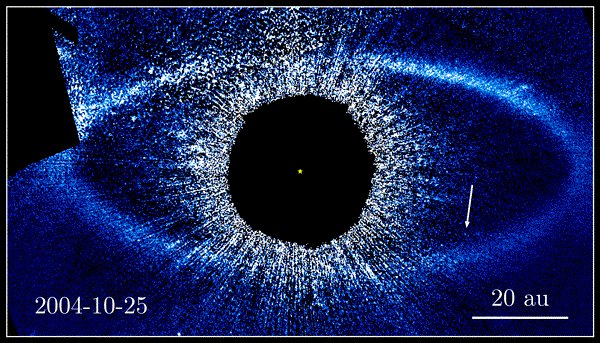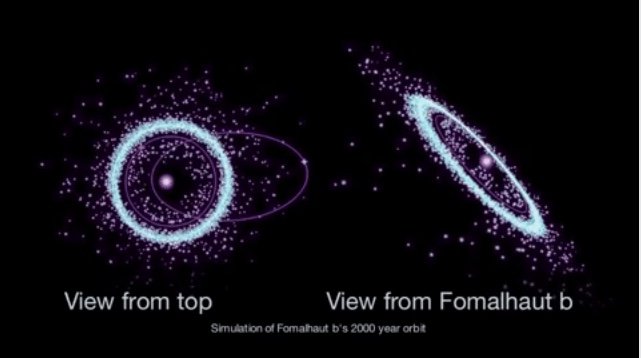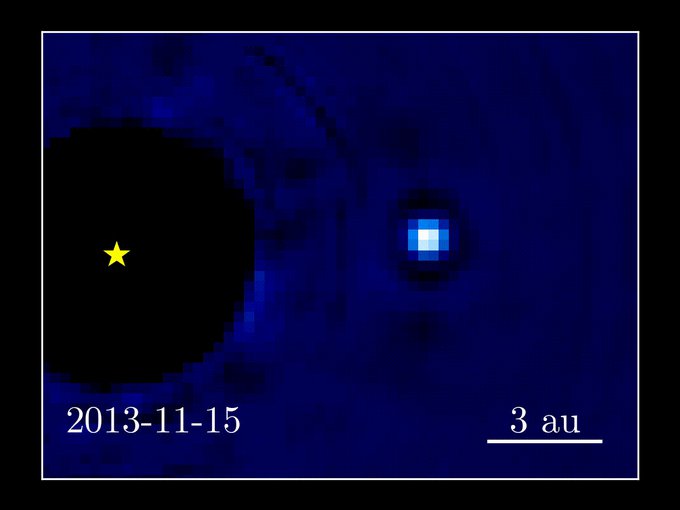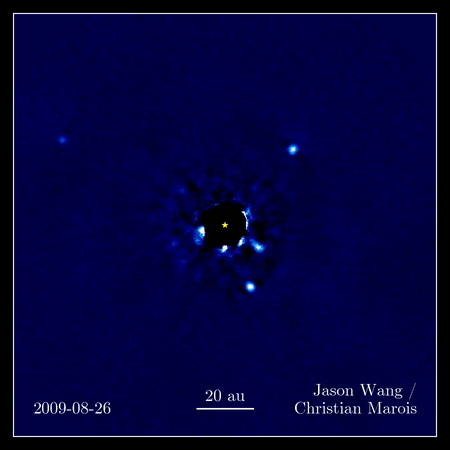
Direct imaging of exoplanets remains in its infancy, but goodness what a treat it is already and what a promise of things to come.
Almost all of the 3,714 exoplanets confirmed so far were detected via the powerful but indirect transit and radial velocity methods — measures of slightly decreased light as a planet crosses in front of its star, or the measured wobble of a star caused by the gravitational pull of a planet.

Fomalhaut b on its 1,700 year elliptica orbit, as seen here in five images taken by the Hubble Space Telescope over seven years. The bar shows a distance of 20 astronomical units, or 20 times the distance from the Sun to the Earth.Image credit: Jason Wang/Paul Kalas; UC Berkeley.
But now 44 planets have also been detected by telescopes — in space and on the ground — looking directly at distant stars. Using increasingly sophisticated coronagraphs to block out the blinding light of the stars, these tiny and often difficult-to-identify specks are nonetheless results that are precious to scientists and the public.
To me, they make exoplanet science accessible as perhaps nothing else so far. Additionally, they strike me as moving — and I don’t mean in orbit. Rather, as when you see your own insides via x-rays or MRIs, direct imaging of exoplanets provides a glimpse into the otherwise hidden realities of our world.
And in the years ahead – actually, most likely the decades ahead — this kind of direct imaging of our astronomical neighborhood will become increasingly powerful and common.
This is how the astronomers studying the Fomalhaut system describe what you are seeing:
“The Fomalhaut system harbors a large ring of rocky debris that is analogous to our Kuiper belt. Inside this ring, the planet Fomalhaut b is on a trajectory that will send it far beyond the ring in a highly elliptical orbit.
“The nature of the planet remains mysterious, with the leading theory being the planet is surrounded by its own ring or a sphere of dust.”
Fomalhaut b was first described in 2008 by Paul Kalas, James Graham and colleagues at the University of California, Berkeley. If not the first object identified through direct imaging — a brown dwarf failed star preceded it, as well as other objects that remain planet candidates — Fomalhaut was among the very first. The data came via the Advanced Camera for Surveys on the Hubble Space Telescope.

Simulation of one possible orbit for Fomalhaut b derived from the analysis of Hubble Space Telescope data between 2004 and 2012, presented in January 2013 by Paul Kalas and James Graham (Berkeley), Michael Fitzgerald (UCLA) and Mark Clampin (NASA/Goddard)Image credit: Paul Kalas.
But Fomalhaut b is an unusual planet by any standard, and that resulted in a lot of early debate about whether it really was a planet. Early efforts to confirm the presence of the planet failed, in part because the efforts were made in the infrared portion of the spectrum.
Instead, Fomalhaut b had been detected only in the optical portion of the spectrum, which is uncommon for a directly imaged planet. More specifically, it reflects bluish light, which again is unusual for a planet. Some contended that the planet detection made by Hubble was actually a noise artifact.
A pretty serious debate ensued in 2011 but by 2013 the original Hubble data had been confirmed by two teams and its identity as a planet was broadly embraced, although the noise of the earlier debate to some extent remains.
As Kalas told me, this is probably because “no one likes to cover the end of a debate.” Nonetheless, he said, it is over.
“Fomalhaut b at age 440 Myr (.44 billion years) is much older than the other directly imaged planets,” Kalas explained. “The younger the planet, the greater the infrared light it emits. Thus it is not particularly unusual that it is hard to image planets in the Fomalhaut system using infrared techniques.”
Kalas believes that a ring system around the planet could be reflecting the light. Another possibility, he said, is that two dwarf planets collided and a compact dust cloud surrounding a dwarf planet is moving through the Fomalhaut system.
That scenario would be very difficult to test, he said, but the alternate possibility of a Saturnian exoplanet with a ring is something that the James Webb Space Telescope will be able to explore.
In any case, the issue of whether or not the possibly first directly-imaged planet is in fact a planet has been resolved for now.
When the International Astronomical Union held a global contest to name some of the better known exoplanets several years ago, one selected for naming was Fomalhaut b, which also now has the name “Dagon.” The star Fomalhaut is the brightest in the constellation Pisces Australis — the Southern Fish — and Dagon was a fish god of the ancient Philistines.
While instruments on the W.M. Keck Observatory in Hawaii, the European Very Large Telescope in Chile and the Hubble Space Telescope have succeeded in directly imaging some planets, the attention has been most focused on the two relatively newcomers. They are the Gemini Planet Imager (GPI), now on the Gemini South Telescope in Chile and funded largely by American organizations and universities, and the largely European Spectro-Polarimetric High-contrast Exoplanet REsearch (SPHERE) instrument, also in Chile.

Still from a video of Beta Pictoris and its exoplanet made using nine images taken with the Gemini Planet Imager over more than two years years. The planet is expected to come out from behind its star later this year, and the GPI team hopes to capture that event.Image credit: Jason Wang; UC Berkeley, Gemini Planet Imager Exoplanet Survey.
In real time, the two instruments correct for distorting atmospheric turbulences around Earth and also block the intense light of the host stars. Any residual incoming light is then scrutinized, and the brightest spots suggest a possible planet and can be photographed as such.
The ultimate goal is have similar instruments improved until they are powerful enough to read the atmospheres of the planets through spectroscopy, which has been done so far only to a limited extent.
Kalas, Graham and Jason Wang (a graduate student at Berkeley who put together the direct imaging movies ) are part of the GPI team, which since 2014 has been searching for Jupiter-sized and above planets orbiting some distance from their suns. The group is a member of NASA’s NExSS initiative to encourage exoplanet scientists from many disciplines to work together.
While GPI has had successes detecting important exoplanets such as 51 Eridani b, it also studies already identified planets to increase understanding of their orbits and their characteristics.
GPI has been especially active in studying the planet Beta Pictoris b, a super Jupiter discovered using data collected by the European Southern Observatory Very Large Telescope. While the data was first collected in 2003, it took five years to tease out the planet orbiting the young star and it took several more years to confirm the discovery and begin characterizing the planet.
GPI has followed Beta Pictoris b for several years now, compiling orbital and other data used for video above.
The planet is currently behind its sun and so cannot be observed. But James Graham told me that the planet is expected to emerge late this year or early next year. It remains unclear, Graham said, whether GPI will be able to capture that emergence because it will soon be moved from the Gemini telescope in Chile to the Gemini North Telescope on Hawaii. But he certainly hopes that it will be allowed to operate until the planet reappears.
The planet 51 Eridani b was the first exoplanet discovered by the GPI and remains one of its most important. The planet is a million times fainter than its parent star and shows the strongest methane signature ever detected on an alien planet, which should yield additional clues as to how the planet formed.

The Gemini Planet Imager when it was being connected to the Gemini South Telescope in Chile.Image credit: Gemini Observatory.
The four-year GPI campaign from Chile has not discovered as many Jupiter-and-greater sized planets as earlier expected. Graham said that may well be because there are fewer of them than astronomers predicted, or it may be because direct imaging is difficult to do.
But Graham said the campaign is actually nowhere near over. Much of the data collected since 2014 remains to be studied and teased apart, and other Jupiters and super Jupiters likely are hidden in the data.
Right now the exoplanet science community, and especially those active in direct imaging, are anxiously awaiting a decision by NASA, and then Congress, about the fate of the Wide Field Infrared Survey Telescope (WFIRST).
Designed to be the first space telescope to carry a coronagraph and consequently a major step forward for direct imaging, it was scheduled to be NASA’s big new observatory of the 2020s.
But the Trump Administration cancelled the mission earlier this year, Congress then restored it but with the caveat that NASA had to provide a detailed plan for its science, its technology and its cost. That plan remains an eagerly-awaited work in progress.
Meanwhile, here is another example of what direct imaging, with the help of soon-to-be Caltech postdoc Jason Wang, can provide. The video of the HR 8799 system went viral when first made public in early last year.
The promise of direct imaging is enormous. The collected photons can be used for spectroscopy that can potentially tell scientists about a planet’s radius, mass, age, effective temperature, clouds, molecular composition, rotation rate and atmospheric dynamics.

The four planet system orbiting the planet HR 8977, partially identified in 2008. This still is from a video created in 2017 after all four planets had been identified via direct imaging and their orbits had been followed for some years.Image credit: Jason Wang of UC Berkeley/Christian Marois of NRC Herzberg.
For a small, potentially habitable planet, direct imaging can measure surface temperate and pressure and determine whether it can support liquid water. It can also potentially determine if the atmosphere is in the kind of disequilibrium regarding oxygen, ozone and perhaps methane that signal the presence of life.
But almost all this is in the future since none of the current instruments are powerful enough to collect that data.
In the meantime, researchers such as Berkeley graduate student Lea Hirsch, soon to be a Stanford postdoc, are focused on using the strengths of the different detection methods to come up with constraints on exoplanetary characteristics (such as mass and radius) that one technique alone could not provide.
For instance, the transit technique works best for identifying planets close to their stars, direct imaging is the opposite and radial velocity is best that detecting large and relatively close-in planets. Radial velocity gives a minimum (but not maximum) mass, while transits provide an exoplanet radius.
What Hirsch would like to do is determine constraints (limits) on the size of exoplanets using both radial velocity measurements and direct imaging.
As she explained, radial velocity will give that minimum mass, but nothing more in terms of size. But in an indirect way for now, direct imaging can provide some maximum mass.

University of California at Berkeley astronomy grad student Lea Hirsch at Lick Observatory. She will be going soon to Stanford University for a postdoc with Gemini Planet Imager Principal Investigator Bruce Macintosh.Image credit: UC Berkeley.
If, for instance, astronomers know through the radial velocity method that exoplanet X orbits a certain star and is twice the size of Jupiter, they can then look for it using direct imaging with confidence that something is there. Let’s say the precision of the imaging is such that if a planet six times the size of Jupiter was present they would — over a period of time — detect it.
A detection would indeed be great and the planet’s mass (and more) would then be known. But if no planet is detected — as often happens — then astronomers still collect important information. They know that the planet they are looking for is less than six Jupiter masses. Since the radial velocity method already determined it was at least larger than two Jupiters, scientists would then know that the planet has a mass of between two and six Jupiters.
“All the techniques in our toolkit {of exoplanet searching} have their strengths and weaknesses,” she said. “But using those techniques together is part of our future because there’s a potential to know much more.”
To view the videos above, visit: http://www.manyworlds.space/index.php/2018/04/30/fomalhaut-b-on-the-move/
